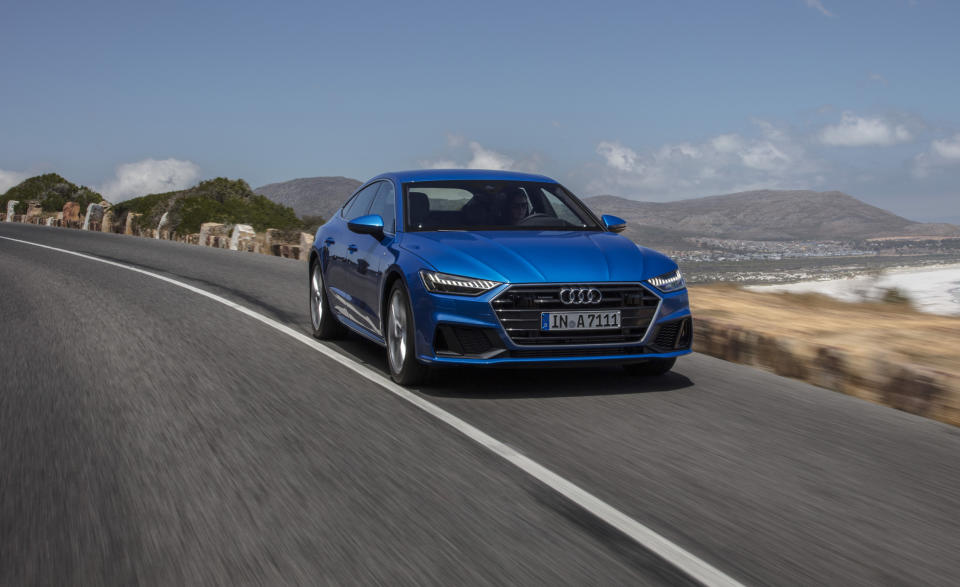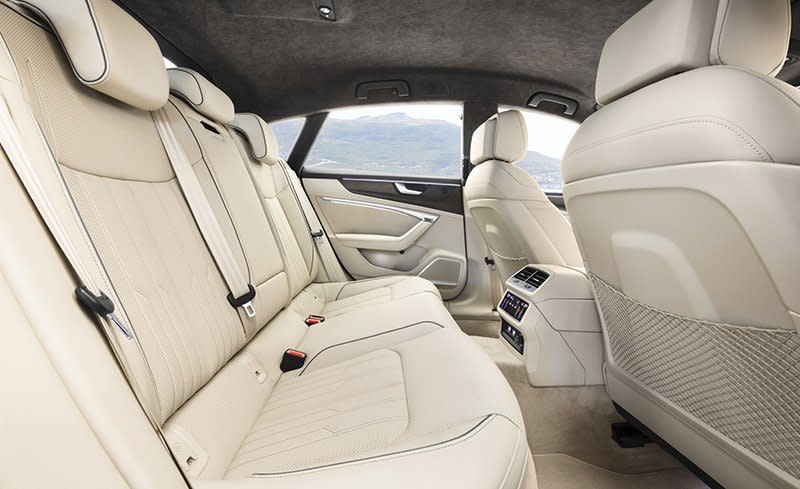2019 Audi A7

Ever since its debut early this decade, the Audi A7 has brought credibility to the “four-door coupe” concept, thanks to the car’s winning combination of luxurious refinement and sporting character wrapped in some particularly fetching sheetmetal. For its follow-up effort, the A7 grows (arguably) even more handsome, but there are greater changes underneath its freshly pressed skin.
The dimensions closely mimic those of the outgoing car, but the design employs more crisp lines and sharp angles. The model is again a hatchback, and at the trailing edge of the liftgate is a spoiler that deploys at 75 mph. Flanking the lower, more hexagonal grille, the A7 offers three different headlight setups: standard LEDs, matrix LEDs, and matrix LEDs with laser high-beams (the last two are as yet unconfirmed for the U.S. market). The taillights, which span the width of the car, consist of 13-element units at each side connected by an LED center strip. The front and rear turn signals light up sequentially, and when the car is locked or unlocked, the front and rear lights perform a little flashy choreography.

The A7 shares its architecture with the redesigned 2019 A8 and the upcoming next-generation A6, although the sub-8s have significantly less aluminum in their final build. The platform’s highlights include a 48-volt hybrid-assist system, greater self-driving capability, and a redesigned MMI interface. For our market, the A7 comes in a single mechanical configuration with a 340-hp turbocharged 3.0-liter V-6, which supplants the 2018 model’s supercharged six of the same displacement and output. It’s paired with Audi’s seven-speed dual-clutch S tronic transmission rather than the eight-speed conventional automatic used previously, and Quattro all-wheel drive is standard.
On the road, the A7 deftly blends polish and performance. The transmission’s light-throttle upshifts are all but imperceptible—in part because the engine is so quiet—and its low-speed behavior is smooth enough to pass for a torque-converter automatic. Yet it’s also quick to snap off downshifts when requested. The turbo six’s maximum torque comes online more than 1500 rpm lower than before and peaks at 369 lb-ft (up from 325 previously), and it’s available over a broad span from 1370 to 4500 rpm. The muscular V-6 effectively motivates the 243-pound-lighter A7 (Audi claims a 4001-pound curb weight), and turbo lag is minimal, if not entirely vanquished. The engine’s flexibility and the transmission’s responsiveness mean that there’s little need to bother with Dynamic mode, which hangs on to lower gears unnecessarily long. Or choose your own ratio with the paddles or the shifter’s plus/minus gate.
A Subtler Sort of Hybrid
The powertrain’s standard 48-volt hybrid element is largely invisible, and will be particularly so in U.S. cars. The system’s regenerative braking recoups up to 16 horsepower while decelerating, stores it in the 48-volt battery located under the cargo floor, and feeds it to the engine’s crankshaft via a belt-driven motor/generator, which also functions as the car’s alternator and stop/start engine starter. The hybrid system doesn’t increase the powertrain’s maximum output but “torque fills” to reduce perceived turbo lag and the V-6’s workload—including allowing it to shut down entirely for engine-off coasting, a function that’s seamless but one we won’t get here. For us, the chief benefit of the 48-volt system is that it allows the auto stop/start feature to operate more smoothly and more often. Cleverly, that system can trigger a restart when the forward-facing radar sees that the vehicle ahead begins moving, rather than waiting for the driver to lift off the brake.

In the U.S. the A7 will offer a choice of standard steel springs or an adaptive suspension with air springs, as on the cars we drove. Audi claims its Drive Select system now offers greater differentiation between its various modes, and the Comfort mode definitely provides the best ride quality while still keeping body motions well controlled. In Auto and Dynamic modes, the 255/40R-20 Michelins acknowledge pavement imperfections with a solid thwack. The Dynamic setting adds some heft to the otherwise overly light steering but doesn’t offer any notable improvement in handling—not that it really needs improving. As revealed on a series of S-bends and switchbacks, the A7 chassis turns in with newfound enthusiasm, and carves corners like an Alpine skier. The cars we drove, however, had the benefit of four-wheel steering, which won’t be offered on A7s in the States (although we may get the feature on the forthcoming S7).
Robots Take the Wheel
Audi’s Level 3 autonomous-driving capability is another feature not coming to the U.S.—at least not until the regulatory clouds disperse. We didn’t get to experience it, but did try out the adaptive cruise control with stop-and-go functionality. It allows for use in city traffic, although if the car is stopped for more than a few seconds the driver needs to prod the accelerator or flick the cruise-control stalk to get going again. We found that cruise-controlled stopping introduced a vibration that wasn’t present otherwise, and the driver still has to be alert, because the adaptive cruise can be caught napping when the car it’s following pulls off the road, revealing stopped traffic ahead. The lane-keeping assist (which works independently of the cruise control) can self-steer for a few moments at a time, but it doesn’t do a great job centering the car in the lane. The A7 also will offer self-parking capability—including from outside the car via a smartphone app.
Screen Gems
The more impressive tech is inside the cabin, where three generously sized screens are on hand to wow showroom-goers (four if you count the small touchscreen that operates the rear climate control). In front of the driver is Audi’s familiar 12.3-inch Virtual Cockpit configurable instrument cluster. It’s joined by an entirely new MMI system that ditches the pop-up display and rotary controller for two touchscreens with haptic feedback that are fully integrated into the dash design and canted toward the driver.

The 10.1-inch upper screen is used primarily for the audio system, the map display (although the map can appear also in the Virtual Cockpit), the camera feed, and to alter the car’s many settings. All climate-control functions move to the 8.6-inch lower screen, with fan speed and temperature adjustable by tapping or by swiping. The lower screen also is where one can finger-draw inputs for Google or navigation searches—the system recognizes whole words, not just one letter at a time. And besides the climate-control display, the lower screen can show programmed shortcuts across the top (four at a time, in up to eight groupings, for 32 total); the shortcuts can be radio presets, navigation destinations, or phone contacts. In the new system only the volume knob survives, along with buttons to call up the driver-assist menu and the exterior camera views. The exterior cameras may be the neatest new feature, offering a 3D view of the car that can be manipulated to see what’s next to the vehicle on any side. And among the various 2D views (front, rear, overhead) is one that can provide a top-down look at the front or rear wheels and warn you when you’re about to curb a rim.
Although the system’s functionality is greatly enhanced, like all touchscreens MMI requires more eyes-off-the-road time than do physical controls. Also, the large lower screen means there’s nowhere to put cellphones and sunglasses other than in the cupholders or the cubby under the center armrest. The latter also is home to an inductive-charging pad and two of the four USB ports (with the other two being in the rear).

As we’ve come to expect in an Audi, the interior materials and design execution are largely above reproach. On our example, smooth leather covered the dash and door tops, with microsuede on the ceiling and door panels. Lighting that outlines the edges of the console and the tops of the doors looks cool at night, but in the daytime the plentiful brushed-metal trim can annoyingly reflect the sun. Audi was able to carve out fractionally more rear-seat legroom, which is now generous, although headroom remains marginal. The rear bench has seatbelts for three; fold it down and the cargo hold offers 49 cubic feet of space—or a still impressive 19 cubes behind the rear seatbacks.
This redesign maintains the A7’s fashionable good looks while bolstering its tech quotient and burnishing its drivability. Even with some of its new elements off-limits, the A7 again presents the best argument for the German confection that is the four-door coupe.
Specifications >
VEHICLE TYPE: front-engine, all-wheel-drive, 5-passenger, 4-door hatchback
ESTIMATED BASE PRICE: $72,000
ENGINE TYPE: turbocharged and intercooled DOHC 24-valve Miller-capable V-6, aluminum block and heads, direct fuel injection
Displacement: 183 cu in, 2995 cc
Power: 340 hp @ 6400 rpm
Torque: 369 lb-ft @ 1370 rpm
TRANSMISSION: 7-speed dual-clutch automatic with manual shifting mode
DIMENSIONS:
Wheelbase: 115.2 in
Length: 195.6 in
Width: 75.1 in Height: 56.0 in
Cargo volume: 19 cu ft
Curb weight (C/D est): 4000 lb
PERFORMANCE (C/D EST):
Zero to 60 mph: 4.4 sec
Zero to 100 mph: 11.2 sec
Standing ¼-mile: 13.1 sec
Top speed: 130 mph
EPA FUEL ECONOMY (C/D EST):
Combined/city/highway: 24/21/30 mpg

 Yahoo Autos
Yahoo Autos 